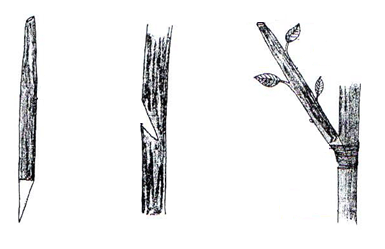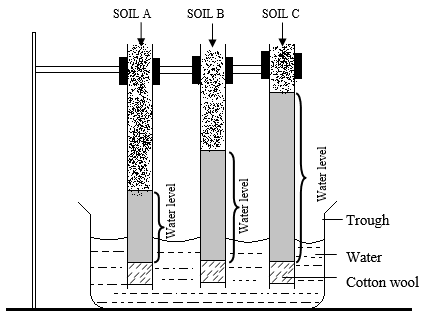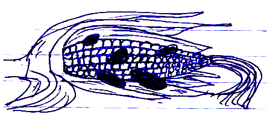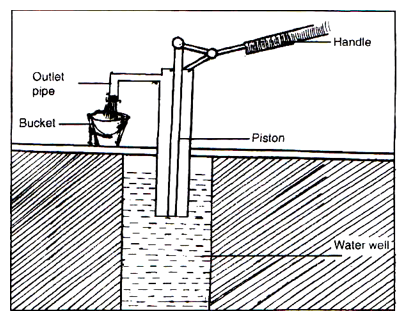QUESTIONS
SECTION A
Answer all questions in the space provided
- State four importance of treating water in the farm (2 marks)
- Explain the importance of the following layers when preparing compost manure.
- Well rotten manure (1 mark)
- Wood ash (1 mark)
- Top soil (1 mark)
- Give two ways in which pest can be categorized depending on their habitat. (1 mark)
- Explain how the following environmental factor affects the effectiveness of herbicides.
- Wind (1 mark)
- Temperature (1mark)
- Rain (1 mark)
- Give the element whose its deficiency in plant is characterized by the following:-
- Blossom end rot in tomatoes (1 mark)
- Intervenial chlorosis in leaves. (1 mark)
- White bud formation and young leaves almost without chlorophyll (1mark)
- State three disadvantages of mulching (1½ marks)
- Differentiate between the following terms:
- Apiculture and aquaculture (1mark)
- Olericulture and pomology (1mark)
- State four biotic factors negatively influencing agriculture (2 marks)
- Give the part in which each of the following crops is harvested
Coffee (½ mark)
Tea (½mark)
Irish potato (½mark) - State three negative effects of excess nitrogenous fertilizer in tomato production (1½ marks)
- State four biological /cultural control measure of soil erosion. (2 marks)
- Differentiate between the following terms
- Fragmentation and subdivision of land. (1mark)
- Undersowing and oversowing (1 mark)
- State four ways in which soil pH can be modified (2 marks)
- Give four characteristics of productive soil. (2 marks)
- Give three factors that should be considered when choosing a seed rate. (1½ marks)
SECTION B (20MARKS)
Answer all the questions in the space provided
- Below is a plant done for quality improvement of crops .Study it carefully and answer questions that follow.

- Identify the practice (1mark)
- Other than the above type of practices ,Give other two types of the practice identified (2 marks)
- Give any two importance of above practice (2 marks)
- Below is a practice used to investigate certain physical property of the soil in different soils. Study it carefully and answer the questions that follow.

- Identify the soil property being investigated (1 mark)
- The set up was left for 24 hrs. and it was later observed that the water had risen up at different levels in different soils as shown above .Identify the soils labelled A,B and C (1½ marks)
- ………………………………………………………………………………………..
- ………………………………………………………………………………………..
- …………………………………………………….……………………………........
- Which soil is suitable for paddy rice growing? (1 mark)
- Other than above property of the soil being demonstrated ,State any other three properties of the soil (1½ marks)
- The diagram below illustrates a maize cob attacked by a disease .Study it carefully and answer questions that follow.

-
- Identify the disease (1 mark)
- Identify the causes of above disease (1mark)
- Apart from maize .Give two other crops that may be attacked by the disease (1 mark)
- State two ways in which the above disease can be controlled (2 marks)
- Below is a pump used to lift water in the farm .Study it carefully and answer the questions that follow

- Identify the type of pump illustrated (1 mark)
- Other than type of pump identified in 19 (a) above ,state other two types of pumps used to lift water in the farm (1 mark)
- Give three ways in which water can be conveyed in the farm (1½ marks)
- State three uses of water in the farm (1½ marks)
SECTION C (40MARKS)
Answer only two questions in this section
-
- Give two main tenure systems (2 marks)
- Explain four advantages of communal categories land tenure system (4 marks)
- State and explain five ways in which herbicides work to kill weeds (10 marks)
- Explain four roles of trees in soil and water conservation (4 marks)
-
- Explain five negative effects of strong wind in crop production (5 marks)
- Explain four branches of agriculture (4 marks)
- Explain six reasons for doing land preparation (6 marks)
- Explain five reasons for carrying out minimum tillage (5 marks)
-
- Explain five factors to be considered when selecting the nursery site (5 marks)
- Explain five characteristic of a nitrogenous fertilizers (5 marks)
- State and explain factors determining spacing of a particular crop (10 marks)
MARKING SCHEME
-
- To remove sediments of solid particles such as solid particles such as soil, sand and sticks
- To remove smell and bad taste
- To remove chemical impurities such as excess fluoride
- To kill disease causing micro-organisms.
-
- To provide nutrients to the micro- organisms responsible for decomposition.
- To improve the level of phosphorus and potassium in the resulting manure
- To introduce micro-organisms necessary for the decomposition of the organic materials.
-
- Storage pest
- Field pest
-
- Wind –may blow away spray wash to unintended plants while decreasing chemical concentration on intended plants.
- Temperature: increases translocation, hence absorption of more herbicides and therefore death of the plant.
- Rain –May dilute or wash away the chemical to non-toxic level;/may make the chemical to leach hence killing unintended plants.
-
- Calcium
- Magnesium
- Iron
-
- Provides breeding ground and hiding places for pests that attack crops.
- Traps light showers of rainfall hence not reaching the soil
- It is fire risk
- Expensive to acquire, transport and apply.
-
- Apiculture refers to rearing of bees in a beehive while aquaculture refers to rearing of fish in a fish pond.
- Olericulture refers to growing of vegetables while pomology refers to growing of fruits.
-
- Pathogens
- Parasites
- Pests
- Weeds
- Predators Any four 4× ½ =2 marks
-
- Coffee-berries/cherries
- Tea –leaves.
- Irish potato-Tuber /stem tuber Rej Root tuber.
-
- Lead to prolonged maturity
- Leads to cracking of fruits before maturity.
- May cause blossom end –rot
- Causes too much of vegetative growth hindering fruit formation.Any 3× ½ =1 ½
-
- Grass strips/filter strips
- Cover cropping
- Contour farming
- Mulching
- Strip cropping
- Grassed /vegetated water ways
- Afforestation/reafforestation
- Agroforestry
- Crop rotation
- Intercropping Any 4× ½ =2 mks
-
- Land fragmentation is a situation whereby a single farmer owns several parcels of land scattered over a wide area while land subdivision is the partitioning of a piece of land into small portions.
- Undersowing is establishment of a pasture under a cover crop, usually maize while oversowing is establishment of pasture legume in an existing grass pasture.
-
- Application of lime
- Application of a basic fertilizer
- Application of acidic fertilizer
- Application of sulphur.4× ½ =2 mks
-
- Good depth
- Properly drained
- Has good holding water capacity
- Has adequate nutrients supply
- Has correct PH
- Free from excessive infestation of soil borne pests and diseases.
-
- Seed purity
- Germination percentage
- Spacing
- Number of seeds per hole
- The purpose of the crop Any 3× ½ =1 ½
-
- Side grafting accept grafting alone
-
- Whip /tongue grafting
- Approach grafting
- Bark grafting
- Notch grafting Any 2×1=2mks
-
- Helps to shorten maturity age of the crop
- Helps to propagate clones that cannot be propagated in any other way.
- Helps to repair damaged trees
- Facilitates changing of the top of tree from being undesirable to desirable.
- Plants with desirable root characteristics e.g. disease resistance, vigorous root system but with undesirable products may be utilized to produce desirable products. Any 2×1=2 mks
-
- Capillarity 1×1=1mk
-
- Sandy soil
- Loam soil
- Clay soil 3× ½ =1 ½ mk
- Soil c/clay soil
-
- Soil structure
- Soil texture
- Soil colour
- Soil water holding capacity
- Soil aeration Any 2×1=2 mks
-
- Smut
- Ustilago spp.
-
- Barley
- Wheat
- Sorghum
- Rye
- Oats
- Sugarcane Any 2× ½ =1 mk
-
- Hot water treatment
- Use of certified seeds
- Crop rotation
- Field hygiene Any 2×1=2mks
-
- Piston /reciprocating pump 1×1=1 mks
-
- Centrifugal /rotadynamic pumps.
- Semi rotary pump
- Hydram 3× ½ =1 ½ mks
-
- Use of canals
- Use of containers
- By use of pipes 3× ½ =1 ½ mks
-
- For domestic purpose in washing utensils, cooking, drinking, washing clothes and cleaning the house.
- For watering livestock, washing animals, cleaning livestock houses, washing farm equipments.
- For diluting chemicals
- Used in processing farm produce
- In the construction of buildings
- For irrigation 3× ½ =1 ½ marks
-
-
- collective tenure system
- Individual tenure system
-
- The problem of landlessness does not exist.
- The land cannot be easily fragmented.
- The system allows for free movement of livestock.
- The land is left to rest for a while so as to allow pasture regeneration.
- No land disputes because the elders of the community will solve any local problems. Any 4×1=4 mks
-
- Inhibition of nitrogen metabolism – herbicide may interfere with the formation of nucleic acid /interfere with enzyme functioning.
- Killing the cell:- The cell wall is destroyed and chemical enters the cell cytoplasm killing it.
- Causing abnormal tissue development:– Herbicide may cause twisting, gall formation.
- Inhibiting photosynthesis –Herbicides interfere with chlorophyll formation.
- Inhibiting respiration –Herbicides block movement of materials from the site of manufacture to other areas.
Correct stating -1mk
Correct explanation -1 mk
5×2=10 marks
-
- They reduce the speed of running water thus reducing its erosive power.
- They protect the soil below from rain drop erosion by reducing the force with which it falls onto the ground.
- They provide shade and reduce loss of moisture through evaporation.
- They act as wind breaks.
- Tree roots bind soil particles together.
- Their leaves decay to supply humus to the soil which improves infiltration rate of the soil. Any 4×1=4 mks
-
-
-
- Increase the rate of evaporation of moisture from the soil reducing water in the soil for plant use.
- Causes lodging in cereals and damage crops.
- Blows away rain bearing clouds causing shortage of rains
- Acts as agent of soil erosion reducing soil fertility
- Increase the rate of evapotranspiration causing wilting in crops.
- Increase the spread of pest and diseases from one crop to another
- Destroy farm structures. Any 5×1=5 mks
-
- Crop production –growing of crops on cultivated land
- Livestock farming –keeping of animals
- Agricultural engineering –Branch that deals with use and maintenance of farm tools, machinery and structures.
- Agricultural economics –Branch that deals with the utilistaion of scarce resources to maximize output while minimizing cost. 4×1=4 marks
(mark as a whole)
-
- To kill weeds
- To incorporate manure and other organic matter into the soil
- To destroy different stages of crop pest e.g. eggs, larvae, pupae and adult
- To aerate the soil
- To encourage penetration of roots in the soil.
- To make subsequent operations possible such as planting, fertilizer application, rolling, ridging
- To encourage water infiltration into the soil. Any 6×1=6 mks
-
- To prevent exposure of humus to adverse conditions such as heat that cause volatilization of nitrogen
- To prevent disturbance of roots and nitrogenous structures e.g. tubers and bulbs
- To conserve moisture by not exposing the soil to sun heat hence reducing evaporation of available moisture.
- To maintain soil structure by reducing number of cultivation
- To reduce cost of cultivation or ploughing by reducing the number of operation
- To control soil erosion when mulching and cover cropping is done.
-
-
-
- Near the water source for easy watering
- Type of soil –should be well –drained, deep and fertile
- Topography –should be gentle sloping to prevent flooding and erosion through run-off.
- Security-should be well protected from theft and destruction by animals and birds.
- Well sheltered place-To prevents strong wind which can uproot seedlings and cause excessive evapotranspiration.
- Previous cropping-Area where the same crop species had been planted should be avoided to prevent buildup of pest and diseases.
- Accessibility-should be where the farmer can reach easily.
Mark as a whole (correct stating &explanation)
Any 5×1=5 mks
-
- They are highly soluble in water
- They are easily leached
- They have short residual effect
- They have scorching /Burning effect on crops
- They are highly volatile
- They are hygroscopic /able to absorb moisture from the atmosphere.
- They are highly corrosive.Any 5×1=5 mks
-
- Growth habit of the crop –spreading and tillering crop varieties require wider spacing than erect type.
- Pest and disease control –crops can be widely spaced to discourage pests and disease causing organisms from moving one crop to another.
- Use of crop –crop grown for forage or silage materials is planted at a closer spacing than for grain production.
- Moisture availability –Areas with a lot of moisture (higher rainfall) are capable of supporting a large number of plants hence closer spacing than areas of low moisture /rainfall.
- The size of the plant –Tall crop varieties require wider spacing while short varieties require closer spacing.
- Soil fertility –A fertile soil can support high plant population hence closer spacing is possible than less fertile soil.
- Type of machinery to be used –the space between the rows should allow free passage of the machinery which can be used in the field.
(Any 5 correctly stated and explained)
Correct stating -1 mk
Correct explanation -1 mk
5×2=10 mks
-
Download Agriculture Paper 1 Questions and Answers - Form 3 End Term 3 2022 Exams.
Tap Here to Download for 50/-
Get on WhatsApp for 50/-
Why download?
- ✔ To read offline at any time.
- ✔ To Print at your convenience
- ✔ Share Easily with Friends / Students

